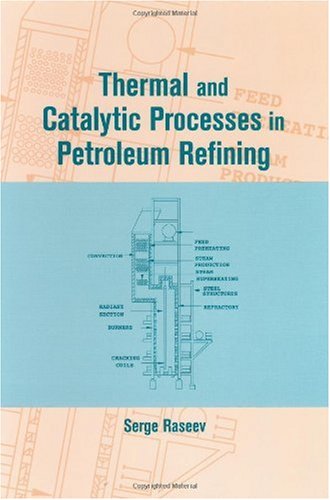

Most ebook files are in PDF format, so you can easily read them using various software such as Foxit Reader or directly on the Google Chrome browser.
Some ebook files are released by publishers in other formats such as .awz, .mobi, .epub, .fb2, etc. You may need to install specific software to read these formats on mobile/PC, such as Calibre.
Please read the tutorial at this link. https://ebooknice.com/page/post?id=faq
We offer FREE conversion to the popular formats you request; however, this may take some time. Therefore, right after payment, please email us, and we will try to provide the service as quickly as possible.
For some exceptional file formats or broken links (if any), please refrain from opening any disputes. Instead, email us first, and we will try to assist within a maximum of 6 hours.
EbookNice Team

Status:
Available4.4
14 reviews
ISBN 10: 0824709527
ISBN 13: 9780824709525
Author: Serge Raseev
This text examines the thermal and catalytic processes involved in the refining of petroleum including visbreaking, coking, pyrolysis, catalytic cracking, oligomerization, alkylation, hydrofining, hydroisomerization, hydrocracking, and catalytic reforming. It analyzes the thermodynamics, reaction mechanisms, and kinetics of each process, as well as
PART I. Thermal Conversion Processes
1. Thermodynamic Analysis of Technological Processes
1.1. Calculation of the Overall Thermal Effect
1.2. Equilibrium Calculations for a Wide Range of Process Conditions
References
2. Thermodynamic Analysis of Technological Processes
2.1. Thermodynamics of Thermal Processes
2.2. Reaction Mechanisms
2.3. Kinetics of Thermal Processes
2.4. Influence of Operating Conditions
References
3. Reaction Systems
3.1. Selection of Reactor Type
3.2. Reaction Systems
References
4. Industrial Implementation of Thermal Processes
4.1. Thermal Cracking at High Pressures and Moderate Temperatures
4.2. Coking
4.3. Pyrolysis
References
5. Elements of Reactor Design
5.1. Design of the Reaction Section of Tubular Furnaces
5.2. Design of Soakers, Coke Drums, and Reaction Chambers
5.3. Systems Using Solid Heat Carrier
References
PART II. Processes on Acid Catalysts
6. Theoretical Basis of Catalytic Cracking
6.1. Process Thermodynamics
6.2. Cracking Catalysts
6.3. Reaction Mechanisms
6.4. Kinetics of Catalytic Cracking
6.5. Effect of Process Conditions
6.6. Catalyst Regeneration
References
7. Industrial Catalytic Cracking
7.1. Feed Selection and Pretreatment
7.2. Process History, Types of Units
7.3. Characteristic Equipment
7.4. Operation Aspects
7.5. Catalyst Demetallation
7.6. Yield Estimation
7.7. Economic Data
References
8. Design Elements for the Reactor-Regenerator System
8.1. Some Fluidization Problems
8.2. Fluidization with Solids Circulation
8.3. Reaction Systems
8.4. Catalyst Regeneration
8.5. Catalyst Entrainment
8.6. Catalyst Circulation, Transport Lines
References
9. Other Processes on Acid Catalysts
9.1. Oligomerization
9.2. Isoparaffin-Olefin Alkylation
References
PART III. Processes on Metallic Catalysts
10. Hydrofining and Hydrotreating
10.1. Process Thermodynamics
10.2. Catalysts
10.3. Reaction Mechanisms
10.4. Process Kinetics
10.5. Effect of Process Parameters
10.6. Industrial Hydrofining
10.7. Industrial Hydrotreating
10.8. Design Elements for the Reactor System
References
PART IV. Processes using Bifunctional Catalysts
11. Hydroisomerization of Alkanes
11.1. Thermodynamics of Hydroisomerization
11.2. Hydroisomerization Catalysts
11.3. Reaction Mechanism
11.4. Kinetics of Hydroisomerization
11.5. Influence of Operating Parameters
11.6. Industrial Hydroisomerization of Lower Alkanes
11.7. Hydroisomerization of Lube Oils and Medium Fractions
References
12. Hydrocracking
12.1. Thermodynamics of Hydrocracking
12.2. Catalysts
12.3. Reaction Mechanisms
12.4. Kinetics of Hydrocracking
12.5. Effect of Process Parameters
12.6. Commercial Hydrocracking of Distillates
12.7. Residue Hydrocracking
12.8. Processes Using Slurry Phase Reactors
12.9. Production of High Grade Oils by Hydrocracking
References
13. Catalytic Reforming
13.1. Thermodynamics
13.2. The Catalysts
13.3. Reaction Mechanisms
13.4. The Kinetics of Catalytic Reforming
13.5. The Effect of Process Parameters
13.6. Catalyst Regeneration
13.7. Commercial Processes
13.8. Elements of Design and Modeling
13.9. Production of Aromatics
13.10. Dehydropolymerization of Lower Alkanes
References
14. Process Combinations and Complex Processing Schemes
14.1. Definition of Objectives
14.2. Evolution of the Range and Specifications of Products
14.3. Additional Resources
14.4. Initial Data for the Selection of Refinery Configuration
thermal and catalytic converter
thermal environmental engineering 3rd edition pdf
thermal catalytic conversion
thermal shock catalytic converter
therm'x catalytic heater
Tags: Serge Raseev, Thermal, Catalytic